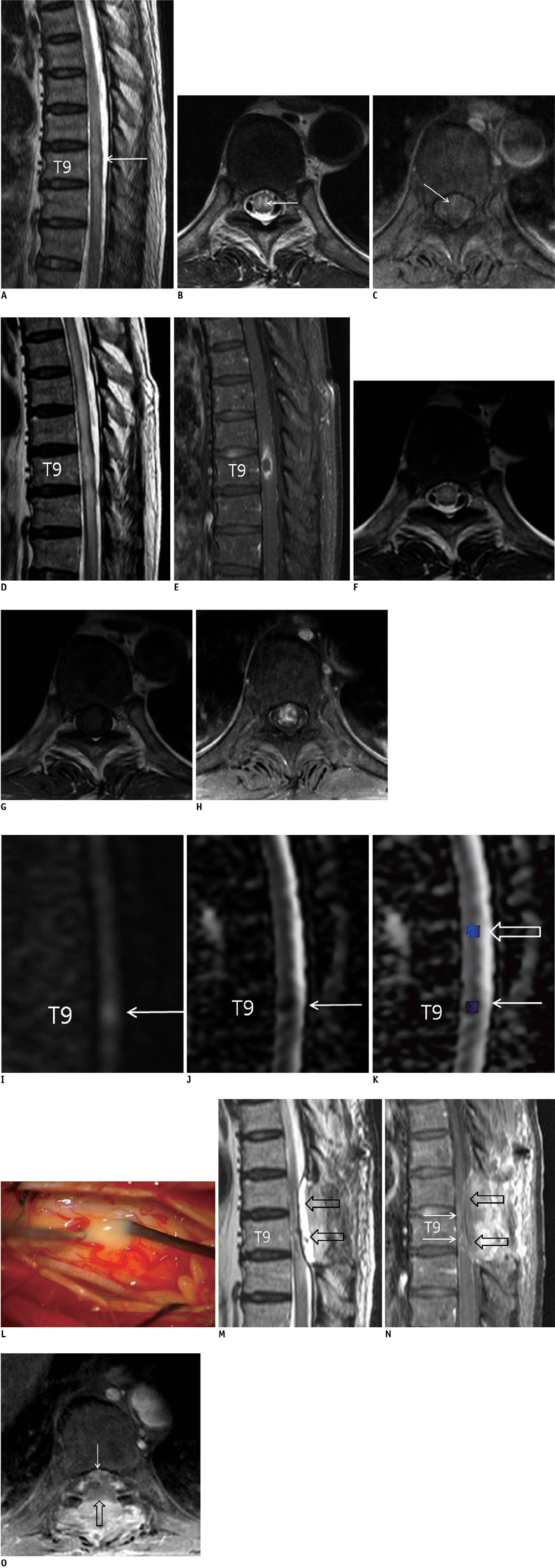Korean J Radiol.
2011 Apr;12(2):241-246. 10.3348/kjr.2011.12.2.241.
Sequential Magnetic Resonance Imaging Finding of Intramedullary Spinal Cord Abscess including Diffusion Weighted Image: a Case Report
- Affiliations
-
- 1Department of Radiology, Chungbuk National University College of Medicine, Chungbuk 361-711, Korea. lsyrad@chungbuk.ac.kr
- KMID: 1088570
- DOI: http://doi.org/10.3348/kjr.2011.12.2.241
Abstract
- Intramedullary spinal cord abscess (ISCA) is a rare infection of the central nervous system. We describe the magnetic resonance imaging (MRI) findings, including the diffusion-weighted imaging (DWI) findings, of ISCA in a 78-year-old man. The initial conventional MRI of the thoracic spine demonstrated a subtle enhancing nodule accompanied by significant edema. On the follow-up MRI after seven days, the nodule appeared as a ring-enhancing nodule. The non-enhancing central portion of the nodule appeared hyperintense on DWI with a decreased apparent diffusion coefficient (ADC) value on the ADC map. We performed myelotomy and surgical drainage, and thick, yellowish pus was drained.
MeSH Terms
Figure
Reference
-
1. Dörflinger-Hejlek E, Kirsch EC, Reiter H, Opravil M, Kaim AH. Diffusion-weighted MR imaging of intramedullary spinal cord abscess. AJNR Am J Neuroradiol. 2009. 31:1651–1652.2. Hart J. Case of encysted abscess in the center of the spinal cord. Dublin Hospital Report. 1830. 5:522–524.3. Kurita N, Sakurai Y, Taniguchi M, Terao T, Takahashi H, Mannen T. Intramedullary spinal cord abscess treated with antibiotic therapy-case report and review. Neurol Med Chir (Tokyo). 2009. 49:262–268.4. Chan CT, Gold WL. Intramedullary abscess of the spinal cord in the antibiotic era: clinical features, microbial etiologies, trends in pathogenesis, and outcomes. Clin Infect Dis. 1998. 27:619–626.5. Al Barbarawi M, Khriesat W, Qudsieh S, Qudsieh H, Loai AA. Management of intramedullary spinal cord abscess: experience with four cases, pathophysiology and outcomes. Eur Spine J. 2009. 18:710–717.6. Hung PC, Wang HS, Wu CT, Lui TN, Wong AM. Spinal intramedullary abscess with an epidermoid secondary to a dermal sinus. Pediatr Neurol. 2007. 37:144–147.7. Clauss HE, Lorber B. Central nervous system infection with Listeria monocytogenes. Curr Infect Dis Rep. 2008. 10:300–306.8. Reiche W, Schuchardt V, Hagen T, Il'yasov KA, Billmann P, Weber J. Differential diagnosis of intracranial ring enhancing cystic mass lesions--role of diffusion-weighted imaging (DWI) and diffusion-tensor imaging (DTI). Clin Neurol Neurosurg. 2010. 112:218–225.9. Marcel C, Kremer S, Jeantroux J, Blanc F, Dietemann JL, De Sèze J. Diffusion-weighted imaging in noncompressive myelopathies: a 33-patient prospective study. J Neurol. 2010. 257:1438–1445.10. Cartes-Zumelzu FW, Stavrou I, Castillo M, Eisenhuber E, Knosp E, Thurnher MM. Diffusion-weighted imaging in the assessment of brain abscesses therapy. AJNR Am J Neuroradiol. 2004. 25:1310–1317.
- Full Text Links
- Actions
-
Cited
- CITED
-
- Close
- Share
- Similar articles
-
- Spinal Cord Infarction Associated with Coronavirus Disease 2019: A Case Report with Magnetic Resonance Imaging Insights
- MR Imaging of Anoperineal Tuberculous Abscess: A Case Report
- Intramedullary Spinal Cord Metastasis
- Acute Spinal Cord Infarction: Diffusion-Weighted MR Imaging: Case Report
- Diffusion Tensor Imaging in Inflammatory and Neoplastic Intramedullary Spinal Cord Lesions: Focusing on Fiber Tracking


